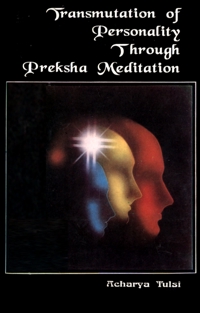
Tranquil yogi, polite and tender,
Neither guileful nor inquisitive,
Capable, humble, master of his senses,
Learned in scripture, in austerities confirmed,
Lover of religion, firm believer,
Fearful of sin, introversive,
Temperate eater of wholesome food, healthful,
Which develops his power of resistance,
Activating the nervous system,
Promoting the development of knowledge!
His love of red colour
Shows him to be possessed of tejoleshya.
The inner current of feeling is of two kinds - clean and unclean. Similarly, the aura is of two kinds - bright and dull.
What kind of feeling or aura one has, is known only to a particular individual, or do even common people come to know it?
Has it any special characteristics?
The purity of feeling and the brightness of the aura are interrelated. Pure feeling makes the aura bright, and a bright aura makes for pure vision. The purity of feelings and colours is a strong factor. But then there are degrees of purity. There exists an evolutionary order in which red, yellow and white are recognised to be pure, the purer, and the purest respectively. The red colour is the entrance door to spiritual development; the yellow is indicative of a stage ahead, and the white of still further development.
Unsteadiness is a problem. Steadfastness is the solution to it. The activation of tejoleshya marks the beginning of the development of mental, verbal and physical stability. The growth of steadiness means the development of religiousness or spirituality. That a man should be religious or spiritual, and yet unsteady, is impossible. More complex than the unsteadiness of body and speech, is the unsteadiness of the mind. With the decrease of mental unsteadiness, there occurs a corresponding decrease in rude or impertinent behaviour, with a corresponding development of politeness.
The greatest impediment in the achievement of stability is the lack of control over the senses and the mind. Indisciplined instincts give rise to pride, deceitfulness and inquisitiveness. With the growth of tejoleshya , all these behaviours begin to change and positive feelings manifest themselves. Arrogance is transformed into gentleness, deceitfulness into sincerity, and inquisitiveness into detachment.
Do the current of feeling and the aura affect only the outward behaviour of a person or does a change also occur in his inner attitude?
As long as unclean leshya and colours are predominant, one's interest in studies remains unrefined. The literature of violence and sex appeals only to those whose current of feeling is uncultured. With the development of tejoleshya the mind begins to evince greater reverence for and growing interest in spiritual and religious books. Disinclination towards penance and austerities is also transformed into intelligent inquiry. Those people do better in sadhana in whom the vibrations of tejoleshya become activated.
The vibrations of tejoleshya turn an individual into a lover of religion and a firm believer therein. In the case of unclean leshya being, dominant, there can be no reverence for religion, nor any strong faith. The mind becomes a prey to doubts on the slightest excuse. In the face of little opposition, or unfavourable circumstances, one's faith begins to waver. But with the refinement of leshya, a positive approach towards religion is awakened. But this in itself is not enough. Without will-power no pledge can be carried out. For a firm determination to continue in the accepted religion and for the acquisition of such capacity, it is necessary to keep alive in oneself the vibrations of tejoleshya.
There is a psychological theory that evil is contagious. An individual gets infected with it without any effort on his part. What should a person do to protect himself from evil?
One great cause of an individual being infected by evil is his lack of resolve to avoid it. There's nothing bad about it, "everybody does it", "That's the way of the world", - such formulations can only serve to push a man further towards evil. The vibrations of tejolesyha create in him a fear of evil or the desire to avoid it. This is a big achievement. It is called "the fear of sin or of doing wrong." Of course, some evils are habitually perpetrated, but even in the evaluation and change of habits, "the fear of sin" plays an important role.
With the development of "the fear of sin" also develops goodwill towards all. An individual, who wishes everybody well, in his own interest and in the interest of all, avoids harmful pursuits and works for the welfare of all. The cause of this mental attitude is the man's innate power of resistance. Whenever in a man's body or mind, the power of resistance or rejection is activated, the atoms of evil cannot assail him. In view of this, the individual who wishes to avoid evil and wants to be associated with universal well-being should purify his feelings.
Resistance or rejection does not constitute action. In the opinion of certain thinkers, the talk of resistance or rejection only blunts action. The vibrations of tejoleshya develop the power of resistance. Does not resistance, then, result in stilling a person's capacity for action?
The red colour denotes agility and vigour. The vibrations of tejoleshya tone up the functioning of the nervous system. Lethargy and inaction disappear. Again action quickens the development of knowledge and knowledge in turn purifies action. Therefore, there is no possibility of the vibrations of tejoleshya causing frustration or stupefaction.
The colour of tejoleshya has been recognised as red. This colour is of two kinds - auspicious and inauspicious. The virtue of the red colour vibrations mentioned earlier is associated with the auspicious red. The vibrations of the inauspicious or dark red give rise to cruelty and passion. Light-red or pink colour is the auspicious-red proper.
Recognising the great contribution of the red colour and of the feelings aroused by it in the evolution of personality, every individual should be active in purifying his current of feeling and his aura.
 Acharya Tulsi
Acharya Tulsi
